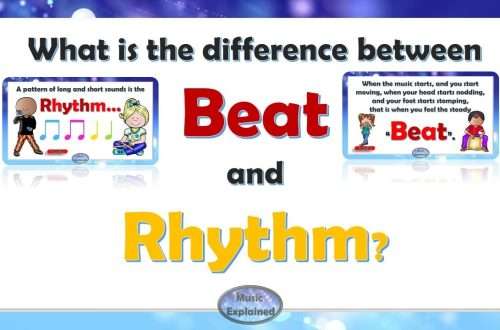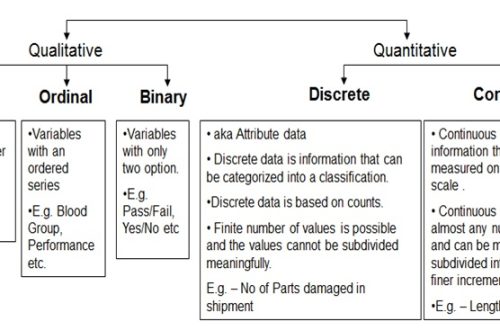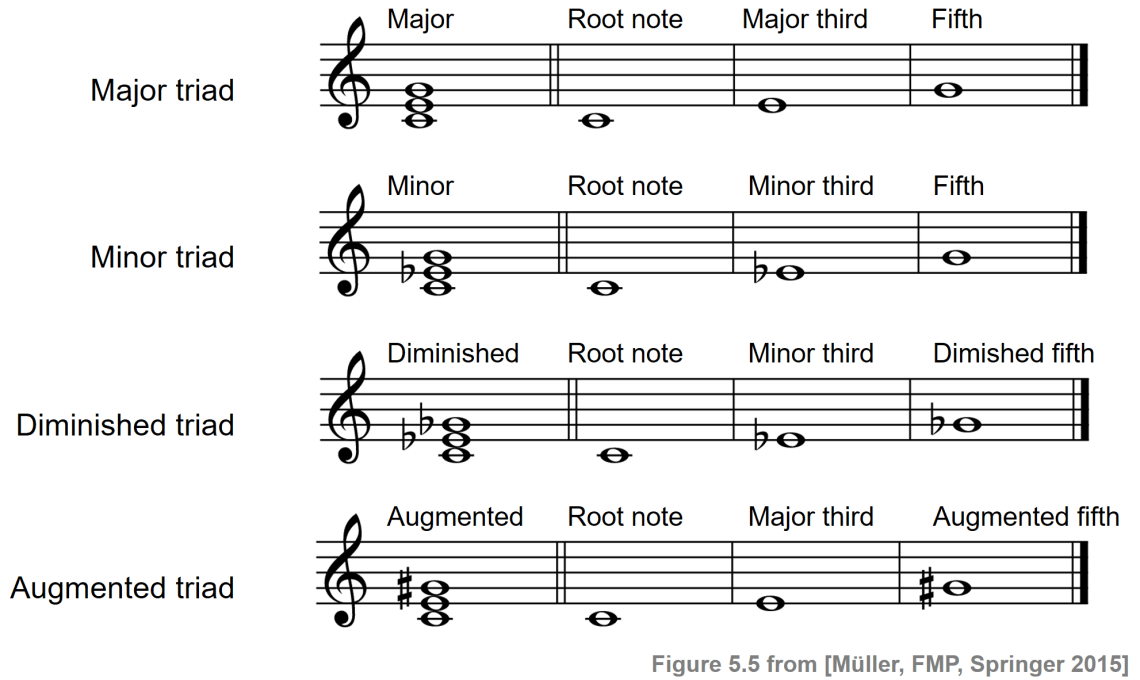
Four types of triads and their inversions
Contents
A triad in music is a chord composed of three sounds, which are arranged in thirds. In order to get a triad, you need to connect only two thirds, but since the interval of a third can be large or small, the combinations of these thirds can be different, and, accordingly, depending on the composition, different types of triads can be distinguished.
In total, four types of triads are used: major (or large), minor (or small), increased and decreased. All triads are denoted by two numbers – 5 and 3, which convey the essence of the structure of the chord (a triad is formed by adding fifth and third intervals to the base).
Major triad
 A major triad is based on a major third, over which a minor is built on top. Thus, the interval composition of this triad is a major third + a minor third. To designate a major (or otherwise large) triad, the capital letter B is used, the full designation is B53.
A major triad is based on a major third, over which a minor is built on top. Thus, the interval composition of this triad is a major third + a minor third. To designate a major (or otherwise large) triad, the capital letter B is used, the full designation is B53.
For example, if we want to build a large triad from “do”, then we will first set aside a large third “do-mi” from this note, then add a small one from “mi” – “mi-sol” on top. The triad came from the sounds DO, MI and SALT.
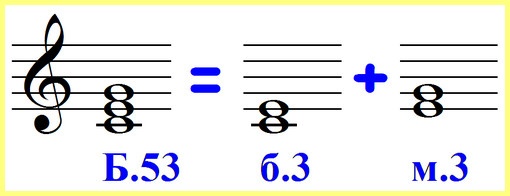
Or, if we build such a triad from “re”, first we write a large third “re f-sharp”, then we attach a small one to “f-sharp” – “f-sharp la”. Thus, the major triad from “re” is the sounds RE, F-SHARP and LA.
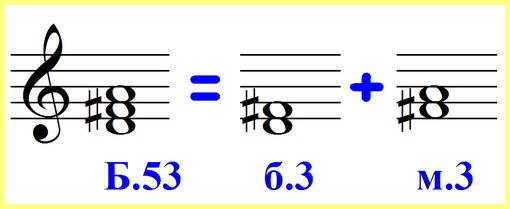
EXERCISE: build orally or in writing, or play on your instrument major triads from other sounds that can be played on the white keys of the piano, that is, from MI, FA, SOL, LA, SI.
SHOW ANSWERS:

- From “mi” – a major triad came from the sounds MI, SOL-SHARP and SI. “Mi G-sharp” is a major third at its base, and “G-sharp B” is a minor third that is added on top.
- From “fa” – a large triad is formed from the sounds FA, LA, DO. “Fa-la” is a major third, and “la-do” is a small one.
- From “sol” – we build a large triad from the sounds of SALT, SI and RE. The major third at the base is the “sol-si”, and the top “si-re” is the minor third.
- From “la” – we collect the major triad from the sounds LA, C-SHARP and MI. At the base, as always, there is a major third “A C-sharp”, and above – a small third “C-sharp mi”.
- From “si” – the sounds of the triad we need – these are SI, RE-SHARP and F-SHARP. Of all the triads that we analyzed today, this is the most cunning and complex, there are two sharps here, which, however, arose for the same reason: there should be a major third at the base, and these are the sounds “C-sharp”, and after should go small third, its sounds are “re-sharp f-sharp”.
[collapse]
Major triads are very common in music – in the melodies of songs or instrumental pieces, as well as in piano or guitar accompaniments, or in orchestral scores.
A vivid example of the use of a major triad in the melody of a song familiar to everyone “Song about the Captain” by Isaac Dunayevsky from the film “Children of Captain Grant”. Remember the famous chorus with the words: “Captain, captain, smile …”? So, at the heart of his melody is precisely the movement down the sounds of a major triad:
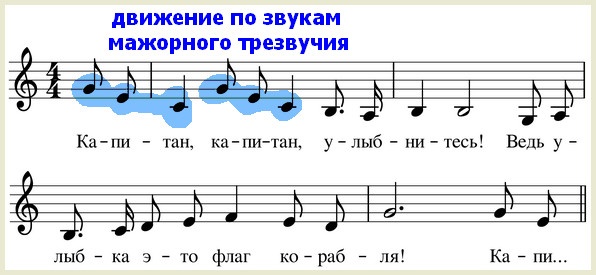
Minor triad
 At the heart of a minor triad lies, respectively, a minor minor third, and a major one is already built over it. Thus, its interval composition will be as follows: minor third + major third. To designate such a triad, the capital letter M is used, and, as always, the numbers 5 and 3 – M53.
At the heart of a minor triad lies, respectively, a minor minor third, and a major one is already built over it. Thus, its interval composition will be as follows: minor third + major third. To designate such a triad, the capital letter M is used, and, as always, the numbers 5 and 3 – M53.
If you build a small triad from “to”, first set aside “to E-flat” – a small third, then add a large one to “E-flat” – “E-flat G”. As a result, we get a chord from the sounds DO, MI-FLAT and SOL.
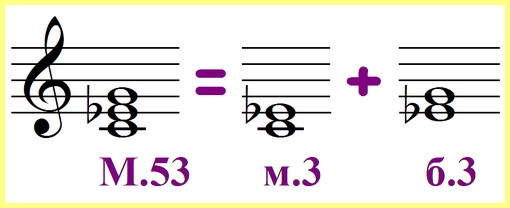
Another example – let’s build a minor triad from “re”. The minor third from “re” is “re-fa”, plus the major third from “fa” is “fa-la”. All sounds of the desired triad, therefore, are RE, FA and LA.
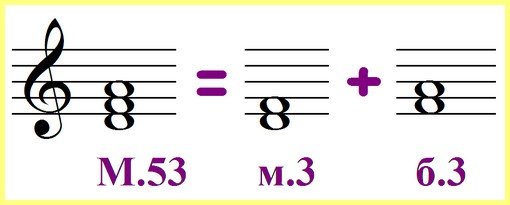
EXERCISE: build minor triads from the sounds MI, FA, SOL, LA and SI.
SHOW ANSWERS:

- From the sound “mi”, a minor triad is formed from the notes MI, SOL, SI, since between “mi” and “sol”, as it should be, there is a small third, and between “sol2 and “si” – a large one.
- From “fa” a small triad passes through the sounds of FA, A-FLAT and DO. At the base lies a small third “F A flat”, and a large third “A flat C” is added to it from above.
- From G, a small triad can be obtained from the sounds G, B-Flat and D, because the lower third must be small (the notes G and B-flat), the upper third must be large (the notes B-flat and “re”).
- From “la” a minor triad is formed by the sounds LA, DO and MI. Minor third “la do” + major third “do mi”.
- From “si” such a triad will be formed by the sounds SI, RE and F-SHARP. It is based on the minor third “si re”, to which a major third is added on top – “re F-sharp”.
[collapse]
The minor triad is also widely used in music in a variety of compositions, sometimes songs begin with its sound. So, for example, the melody of the most famous hit of its time, the song “Moscow Nights” by composer Vasily Solovyov-Sedoy. At the very beginning, on the words “Not heard in the garden …”, the melody just passes through the sounds of a small triad:
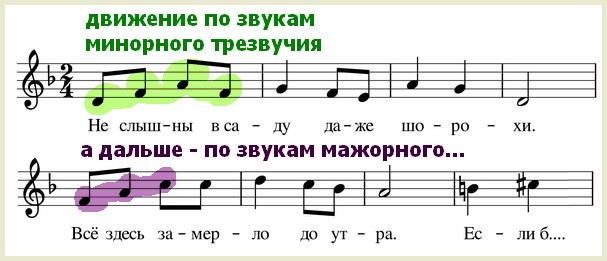
Augmented triad
 An augmented triad is obtained when two major thirds are joined. To record a triad, the abbreviated designation “Uv” is used, to which the numbers 5 and 3 are added, indicating that the chord is precisely a triad – Uv53.
An augmented triad is obtained when two major thirds are joined. To record a triad, the abbreviated designation “Uv” is used, to which the numbers 5 and 3 are added, indicating that the chord is precisely a triad – Uv53.
Consider examples. From the sound “do”, the increased triad goes along the notes DO, MI and SOL-SHARP. Both thirds – “to mi” and “mi sol-sharp”, as it should be, are large.
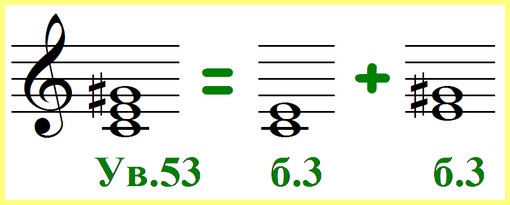
From the rest of the sounds, you, already having some experience, can easily build such triads on your own, which we suggest you do immediately. In order for you to check yourself, we will hide the answers in the spoiler for now.
SHOW ANSWERS:

[collapse]
Augmented triad, like major and minor, is naturally used in music in many cases. But due to the fact that it sounds unstable, musical works, as a rule, do not begin with it. An augmented triad can be found mainly in the middle of a song or instrumental piece.
Reduced triad
 A diminished triad is the exact opposite of an augmented chord. It consists of two small thirds. The principle of designation is similar: the abbreviated notation “Um” and the numbers of the triad (5 and 3) – Um53.
A diminished triad is the exact opposite of an augmented chord. It consists of two small thirds. The principle of designation is similar: the abbreviated notation “Um” and the numbers of the triad (5 and 3) – Um53.
If we are building a reduced triad from the sound “to”, then we need to build and connect two small thirds: the first is “to E-flat”, the second is “E-flat G-flat”. So, we got the following: DO, MI-FLAT and G-FLAT – these are the sounds that form the triad we need.
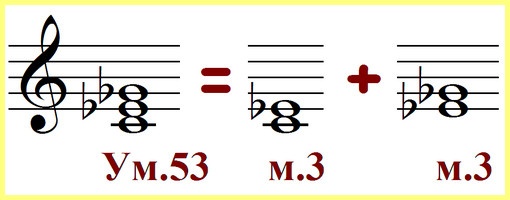
Reduced triads from the remaining main steps (RE, MI, FA, SOL, LA, SI) build yourself. You can see the answers for self-test in the spoiler below.
SHOW ANSWERS:

[collapse]
Just like the augmented triad, the diminished one sounds tense and unstable, so it is very rarely used at the beginning of a piece, much more often this chord can be found in the middle or at the end of a song or piece for some instrument.
How to learn to distinguish 4 types of triads by ear?
In solfeggio lessons in music schools or colleges, there is a form of work like auditory analysis, when the student is asked to guess which chord or interval is currently sounding on the piano or on another instrument. How to remember the sound of the four types of triads, how to learn to distinguish them and not confuse them with each other?
You may have heard the saying: “Everything is known in comparison.” This idea from folk wisdom is applicable here at the right time. It is necessary to sing and play all kinds of triads, memorize their sound and identify their similarities and differences.
Let’s try to characterize each of the triads:
- Major triad sounds confident, bright, bright.
- Minor triad also sounds stable, but with a hint of darkness, it is darker.
- Augmented triad sounds unstable and bright, like a siren, very attention-grabbing.
- Reduced triad also sounds unstable, but it is, as it were, more compressed, faded.
Listen to these types of triads, built from the sound of RE, several times and try to remember the features of each of them.

Reversal of triads: sixth chord and quartersextachord
Any harmonies, including triads, can be reversed – that is, by rearranging the sounds to get new types of chords. All conversions are performed according to the same principle: the lower sound of the original chord is transferred an octave higher, resulting in a different chord.
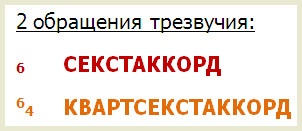 All triads have two inversions: the first is called the sixth chord, and the second is called the fourth-sixth chord. Sixth chords are indicated by the number 6, quarter-sextchords are indicated by two numbers: 6 and 4.
All triads have two inversions: the first is called the sixth chord, and the second is called the fourth-sixth chord. Sixth chords are indicated by the number 6, quarter-sextchords are indicated by two numbers: 6 and 4.
For example, let’s perform the inversion of the major triad “do-mi-sol”. We transfer the lower sound “to” an octave higher, we simply rewrite the rest of the sounds, leaving them in their places. We got the sixth chord “mi-sol-do”.
Now we will execute the following call, we will work with the sixth chord we have received. We move the lower sound “mi” up to the interval of a pure octave, we simply rewrite the rest of the sounds. Thus, we obtain a quarter-sextakcord from the sounds of “sol-do-mi”. This was the second and last one.
If we try to make one more appeal, then we will return to what we originally started from. That is, if you move the bass “G” an octave higher in the “sol-do-mi” quarter-sextakcord, you get an ordinary “do-mi-sol” triad. Thus, we are convinced that the triad really has only two inversions.
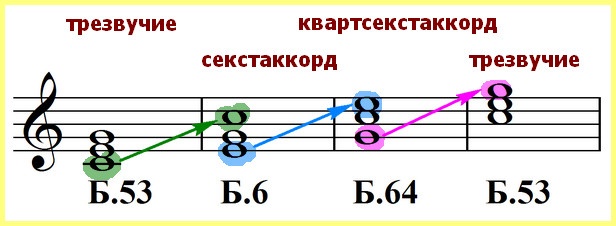
How to determine the interval compositions of sixth chords and quartersextachords?
Since the triad has only four types, it means that there will also be sixth chords and fourth-sixth chords each – major, minor, increased and decreased. To determine the interval compositions of new chords, let’s build them.
For example, let’s take triads from the sound of MI and immediately perform their first and second inversions to get sixth chords and quarter-sextchords. Then we will analyze the resulting chords and see what intervals they consist of.
Major sixth chord and quarter sixth chord
Major triad from MI, these are the sounds of MI, SOL-SHARP and SI. Therefore, the major sixth chord (B.6) will be formed by the sounds G-SHARP, SI and MI – in that order. And a large quarter-sextakcord (B.64) will be composed of the notes SI, MI and SOL-SHARP.
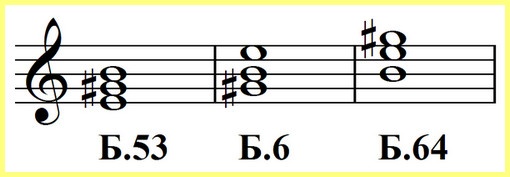
By itself, a major triad consists of two thirds – major and minor, we already know this.
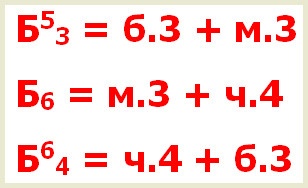 A major sixth chord is made up of a minor third (in our example, it is “sol-sharp si”) and a pure fourth (“si-mi” move).
A major sixth chord is made up of a minor third (in our example, it is “sol-sharp si”) and a pure fourth (“si-mi” move).
A major quarter-sext chord begins with a perfect fourth (the sounds of “si-mi” at the base of the chord), to which a major third is then added (in the example – “mi sol-sharp”).
Thus, we have received the following rule: B.6 = minor third + pure fourth; B.64 uXNUMXd pure fourth + major third.
Minor sixth chord and quarter sixth chord
A small triad from MI is built according to the sounds MI, SOL, SI (without unnecessary accidentals). This means that the minor sixth chord (M.6) is the notes SOL, SI, MI, and the minor quarter-sextakcord (M.64) is SI, MI, SOL.

A minor triad is formed by two thirds – a small “E-sol” and a large “sol-si”.
 A small sixth chord consists of a major third (sol-si sounds) and a pure fourth (si-mi sounds), while a small quarter-sext chord, on the contrary, begins with a fourth (in the example, “si-mi”), to which a small third (in the example, these are the sounds “mi-sol”).
A small sixth chord consists of a major third (sol-si sounds) and a pure fourth (si-mi sounds), while a small quarter-sext chord, on the contrary, begins with a fourth (in the example, “si-mi”), to which a small third (in the example, these are the sounds “mi-sol”).
Thus, we found out that: M.6 = major third + pure fourth; M.64 uXNUMXd pure fourth + small third.
Augmented sixth chord and quartersextachord
The augmented triad from MI is the chord MI, G-SHARP, C-SHARP. The sixth chord of this triad is G-SHARP, B-SHARP, MI, and the quarter-sext chord is B-SHARP, MI, G-SHARP. An interesting feature of all three chords is that they all sound like an augmented triad (only built from different sounds).

An augmented triad, as we already know, consists of two major thirds (in the example, these are “E G-sharp” and “G-sharp C-sharp”).
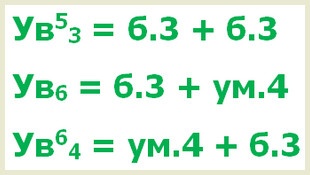 The sixth chord of an augmented triad is a major third (in the example – “G-sharp C-sharp”), to which a diminished fourth is added (in the example – “B-sharp E”).
The sixth chord of an augmented triad is a major third (in the example – “G-sharp C-sharp”), to which a diminished fourth is added (in the example – “B-sharp E”).
The quadrant-sextakcord of the same triad is a diminished quart (mi sol-sharp) and a major third (from sol-sharp to c-sharp).
The conclusion is as follows: SW.6 = major third + reduced fourth; Uv.64 uXNUMXd reduced fourth + major third.
Diminished sixth chord and quarter-sext chord
The reduced triad from the sound MI is a consonance from the notes MI, SOL, SI-FLAT. The sixth chord of this triad is G, B-flat and MI, and its quarter-sext chord is B-flat, MI, G.
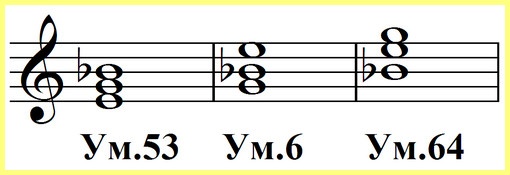
The triad under consideration is symmetrical, it consists of two small thirds (in our case, these are the sounds “mi sol” and “sol si-flat”).
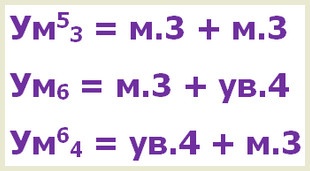 A reduced sixth chord is obtained by linking a small third (we have “G-flat”) with an increased quart (in the example, “B-flat”).
A reduced sixth chord is obtained by linking a small third (we have “G-flat”) with an increased quart (in the example, “B-flat”).
A diminished quartsextakcord starts with an enlarged quart (according to the example – “si-flat mi”), to which a small third (“mi sol”) joins.
So, as a result, it turns out this: Um.6 u64d minor third + increased fourth; Um.XNUMX = augmented fourth + minor third.
Table of interval compositions of three-sound chords
Let’s summarize all the data we’ve got about interval chord compositions in a table. You can download the same table for printing. HERE and use it as a cheat sheet in solfeggio lessons or in homework until you firmly remember it.
sobriety | SEXT- CHORDS | QUARTZEXT- CHORDS | |
MAJOR | B.53 = b.3 + m.3 | B.6 = m.3 + h.4 | B.64 u4d part 3 + b.XNUMX |
MINOR | M.53 = m.3 + b.3 | M.6 = b.3 + p.4 | M.64 = part 4 + m.3 |
ENLARGED | Uv.53 = b.3 + b.3 | Uv.6 = b.3 + um.4 | Uv.64 = um.4 + b.3 |
REDUCED | Mind.53 = m.3 + m.3 | Mind.6 = m.3 + uv.4 | Mind.64 = uv.4 + m.3 |
Why do you need to know what intervals this or that chord is composed of? This is necessary in order to easily build the desired consonance from any musical sound.
For example, let’s build all the chords we have considered today from the sound PE.

- We have already built a large triad from PE, we will not comment on it further. These are the sounds RE, F-SHARP, LA. Major sixth chord from RE – RE, FA, SI-FLAT (“re-fa” is a small third, and “fa B-flat” is a pure quart). The major quarter-sextakcord from the same note is RE, SOL, SI (pure quart “re-sol” and major third “sol-si”).
- Small triad from RE – RE, FA, LA. The minor sixth chord from this note is RE, F-sharp, SI (major third “re F-sharp” + pure fourth “F-sharp si”). Minor quarter-sextakcord from PE – PE, SOL, SI-FLAT (pure quart “D-Sol” + small third “G-flat”).
- Increased triad from RE – RE, F-SHARP, A-SHARP. Increased sixth chord from RE – RE, F-SHARP, SI-FLAT (first the major third “D-F-sharp”, then the reduced quart “F-sharp B-flat”). Increased quarter-sextakcord from the same sound – RE, G-flat, B-flat (reduced quart at the base “D G-flat” and a major third above it “G-flat B-flat”).
- Reduced triad from RE – RE, FA, A-FLAT. The reduced sixth chord from this sound is RE, FA, SI (“re-fa” is a small third, “fa-si” is an increased fourth). Reduced quarter-sixth chord from PE – PE, G-SHARP, SI (increased fourth at the base “D-sharp”, and a small third above it “G-sharp SI”).
All triad inversions have their own expressive power and are widely used in music in a variety of works.
Dear friends, this is where we will stop our big lesson. If you have any questions about the issue, please write them in the comments to this article. If something, it seems to you, is not explained very clearly, also feel free to express your opinion on this matter. We are constantly working to improve the quality of our materials.
In the next issues, we will return to the study of triads more than once. Very soon you will learn about what the main triads of the mode are, and about what important functions they perform in music.
In parting, we will throw you some wonderful music. This music, by the way, begins with a minor quarter-sext chord!
L. van Beethoven – Moonlight Sonata (Spanish: Valentina Lisitsa)



